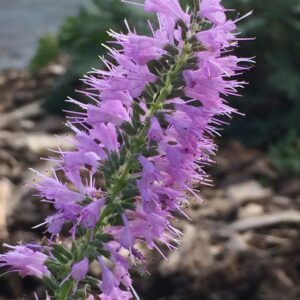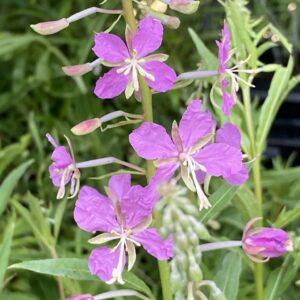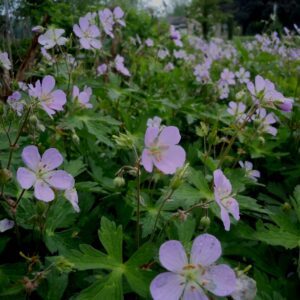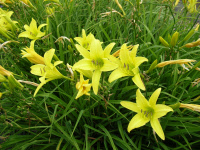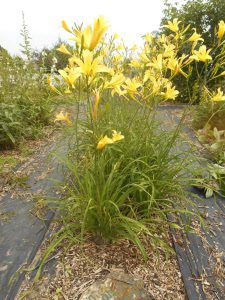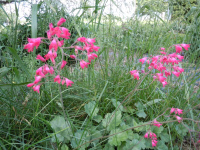Plants for Hummingbirds
Showing 25–32 of 82 results
-
Elsholtzia stauntonii mu xiang ru in China, Chinese mint Z 4-8
Tube-shaped purple flowers ascend in spires in fall on this subshrub that dies back in colder areas to regrow from the roots in spring. Valuable for its late bloom and fragrant foliage.
Tube-shaped purple flowers ascend in spires in fall on this subshrub that dies back in colder areas to regrow from the roots in spring. Valuable for its late bloom and fragrant foliage.
Size: 3-5’ x 3-5'
Care: sun in moist well-drained to well-drained soil
Native: hills, mountainsides and river banks in Gansu, Hebei, Henan, Shaanxi, Shanxi, ChinaNaemd for name Prussian horticultulurist and doctor Johann Sigismund Elsholtz (1623-1688). This species described in 1833.
-
Epilobium angustifolium syn. Chamaenerion angustifolium Fireweed Z 2-7
Bright pink to lilac purple flowers June-July atop red stems covered in willow-like leaves
OUT OF STOCK
Bright pink to lilac purple flowers June-July atop red stems covered in willow-like leaves
Size: 2-6’ x 3’ spreading
Care: Sun to part shade in dry to moist well drained soil
Native: Circum-polar to the temperate northern hemisphere. Wisconsin native.
Wildlife Value: Attracts hummingbirds, bees, and butterflies. Host for Fireweed Clearwing moth and Nessus Sphinx moth. Fireweed pollen yields a honey so prized that some Canadian beekeepers drive - or even fly - their hives to areas rich in fireweed for the blossoming season.Common name comes from its quick reappearance after a wildfire. Native Americans used fireweed externally for burns and other skin conditions and made a tea for gastro-intestinal and bronchial problems. Its shoots eaten as a vegetable and young leaves added to salads. Described and named in 1753.
**LISTED AS OUT OF STOCK BECAUSE WE DO NOT SHIP THIS ITEM. IT IS AVAILABLE FOR PURCHASE AT OUR RETAIL LOCATION.
-
Gaura lindheimeri syn. Oenothera lindheimeri White gaura, Beeblossom Z 5-9
Multitudes of small white/pink. 4-petaled blossoms on wiry stems from May to October. Cut back by half in July to increase blossoms, as though the hoards are not enough.
OUT OF STOCK
Multitudes of small white/pink. 4-petaled blossoms on wiry stems from May to October. Cut back by half in July to increase blossoms, as though the hoards are not enough.
Size: 36” x 36”
Care: Full sun in well-drained to moist well-drained acidic soil
Native: Texas and Louisiana
Wildlife Value: deer & rabbit resistant. Source of pollen for bees, butterflies and hummingbirds
Awards: Royal Horticultural Society Award of Merit.Gaura is from the Greek gauros meaning superb. Collected in 1851 by German plant hunter Ferdinand Lindheimer (1801-1879) in the Texas Hill Country. Lindheimer considered the Father of Texas botany. L.H. Bailey (1913) wrote: “The best kind is Gaura lindheimeri which has white flowers of singular appearance, with rosy calyx tubes.”
-
Geranium maculatum American Cranesbill, Wild geranium, Spotted geranium Z 3-8
Saucer-shaped, five rose-pink to lilac oval petals with darker veins to the center, guiding pollinators to its nectar, surround ten upright stamens bearing yellow pollen in the center bloom in mid to late spring and early summer if cool.
Saucer-shaped, five rose-pink to lilac oval petals with darker veins to the center, guiding pollinators to its nectar, surround ten upright stamens bearing yellow pollen in the center bloom in mid to late spring and early summer if cool.
Size: 24" x 18"
Care: Full sun to part shade in moist to moist well-drained soil
Native: East North America, Wisconsin native.
Wildlife Value: Nectar and pollen source for hummingbirds, bees and butterfliesNative Americans taught colonists to use the plant to cure diarrhea, dysentery and hemorrhaging. Also used on sores, open wounds, canker sores and sore feet. The Choctaw prescribed it for venereal disease. Sent to Europe in 1732 This species collected by French planthunter André Michaux (1746-1802) who spent 11 years collecting plants in the US. Jefferson asked John Bartram to obtain seeds, 1786. Pressed specimen in Emily Dickinson’s herbarium.
-
Hemerocallis ‘Hyperion’
Midsummer, fragrant lemon yellow trumpets
Midsummer, fragrant lemon yellow trumpets
Size: 36" x 12"
Care: Sun, moist well-drained soil. Drought tolerant.Hybrid origin, bred in 1925 and still popular today.
-
Hemerocallis multiflorus Many-flower daylily in China called duo hua xuan cao Z 4-8
Elegant, tall, upright sunshine yellow flowers on this species daylily
Elegant, tall, upright sunshine yellow flowers on this species daylily. Grow for its height & unrivaled number of flowers. Each scape (leafless stem) will produce up to 100 blooms so that this blooms an extraordinary length of time, July-September
Size: 36-40” x 18-24”
Care: sun to part shade in moist well-drained soil
Native: openings in forests on hills in province Honan at Ki Kung Shan, China
Wildlife Value: attracts hummingbirdsThis species grown by Rev. C. Woolly Dod in Malpas, Cheshire England in 1880, The Garden, an Illustrated Weekly Journal of Gardening. Hemerocallis is Greek meaning “flower for a day.”
-
Hesperaloe parviflora Red Yucca Z 6-9
Cerise scarlet trumpets up and down the flower spike in summer
OUT OF STOCK
Cerise scarlet trumpets up and down the flower spike in summer
Size: 3’ x 5’
Care: sun moist well-drained to dry soil
Native: Europe, west & central Asia
Wildlife Value: Attracts butterflies & hummingbirds. Deer and rabbit tolerant,Named by Dr. George Engelmann, a German physician and plant fanatic who emigrated to America in the early 1800’s, settling in St. Louis.
-
Heuchera sanguinea Coral bells, Alumroot Z 3-8
Coral red flowers in late spring through early summer. “One of the finest hardy perennials recently introduced …bright crimson flowers…very graceful,” Farquhar Catalog, 1893.
Coral red flowers in late spring through early summer. “One of the finest hardy perennials recently introduced …bright crimson flowers…very graceful,” Farquhar Catalog, 1893.
Size: 12" x 12"
Care: sun to part shade in moist well-drained soil.
Native: Western U.S.- Rocky MountainsGenus Heuchera named for Johann Heinrich von Heucher (1677-1747) professor of medicine at Wittenburg University. This species collected Be Dr. Frederick Adolph Wislizenus in the Porphyry Mountains of Llanos Mexico on the Col. Doiphan Expedition in 1846-7. Named by Dr. George Engelmann, (1809-1884) physician and avid botanist encouraging and supporting those who explored for plants. He emigrated from Germany and settled in St. Louis. Plant popular in the 1880’s.

